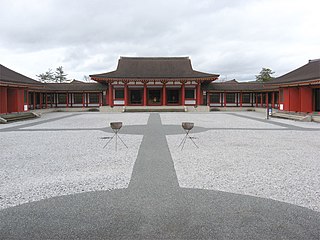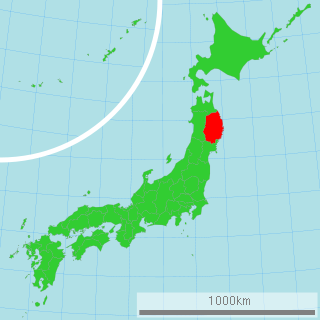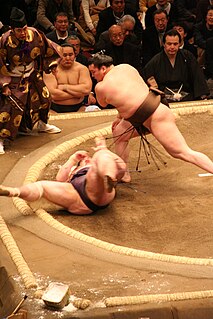
Makuuchi (幕内) or makunouchi (幕の内), is the top division of the six divisions of professional sumo. Its size is fixed at 42 wrestlers (rikishi), ordered into five ranks according to their ability as defined by their performance in previous tournaments.

Aminishiki Ryūji is a Japanese sumo wrestler. He made his professional debut in 1997 and reached the top makuuchi division in 2000. He has earned twelve special prizes and won eight kinboshi or gold stars for defeating yokozuna during his career, the most amongst active wrestlers. He has twice been runner-up in a tournament. The highest rank he has reached is sekiwake. He is in the all-time top ten for a number of sumo records, including most top division wins, most top division appearances and most tournaments ranked in the top division. He wrestles for Isegahama stable.

Terao Tsunefumi is a Japanese former sumo wrestler. He was born in Tokyo, but brought up in Kajiki, Aira District, Kagoshima, Japan. He fought out of Izutsu stable. The highest rank he reached was sekiwake. Despite his relatively light weight he had an extremely long career, spanning 23 years from 1979 until 2002, and was known as the "iron man" of sumo. He is now the head coach of Shikoroyama stable.
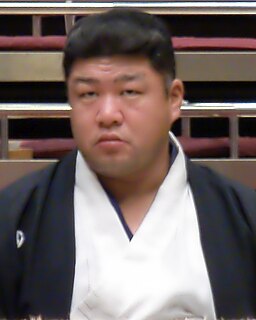
Musōyama Masashi is a former sumo wrestler from Mito, Ibaraki, Japan. A former amateur champion, he turned professional in January 1993, and he won promotion to the top makuuchi division in just four tournaments. He won thirteen special prizes and spent a total of 31 tournaments at komusubi and sekiwake before finally reaching the second highest rank of ōzeki in 2000, shortly after winning his only top division tournament championship or yūshō. He retired in 2004. He is now the head coach of Fujishima stable.
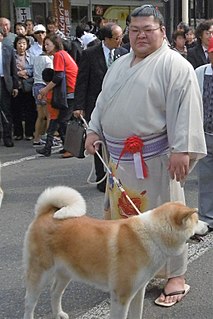
Takekaze Akira is a former professional sumo wrestler from Akita Prefecture, Japan. A former amateur sumo champion, he turned professional in 2002, reaching the top makuuchi division the following year. He was a runner-up in one tournament, earned two special prizes for Fighting Spirit, and one gold star for defeating a yokozuna. Takekaze is in first place for the slowest promotion from makuuchi debut to the third highest sekiwake rank in history. Aged 35 years and 2 months, he is in first place for the eldest to make his sekiwake debut post World War II. He was a member of Oguruma stable. He retired in January 2019 to become an elder of the Japan Sumo Association under the name Oshiogawa Oyakata.
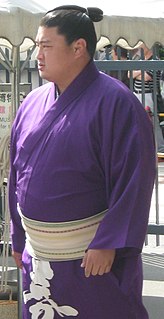
Yoshikaze Masatsugu is a sumo wrestler from Saiki, Oita Prefecture, Japan. His highest rank has been sekiwake. A former amateur sumo champion, he turned professional in 2004, reaching the top division two years later. Until his promotion to komusubi in May 2014 he had the active record for the longest serving makuuchi wrestler who had never reached a titled rank. His best performance in a tournament came in July 2015 when he was the runner-up and scored twelve wins against three losses. In the following tournament in September 2015 he defeated two yokozuna and won special prizes for Outstanding Performance and Technique. Yoshikaze is in second place for the slowest promotion from makuuchi debut to the third highest sekiwake rank in history, behind only his stablemate Takekaze. He has won ten special prizes in total, and eight gold stars for defeating yokozuna.

Wakamisugi Akiteru, also known as Daigō Hisateru, was a sumo wrestler from Kagawa, Japan. The highest rank he achieved was sekiwake. He was the brother in law of yokozuna Wakanohana Kanji I.

Takanowaka Yūki is a former sumo wrestler from Ikitsuki, Nagasaki, Japan. His highest rank was sekiwake.
Hasegawa Katsutoshi is a former sumo wrestler from Kurisawa, Hokkaido, Japan. He began his professional career in 1960, reaching the top division in 1965. He won eight special prizes for his achievements in tournaments and earned nine gold stars for defeating yokozuna. He won a tournament championship or yūshō in 1972 and was a runner-up in two other tournaments. His highest rank was sekiwake. He retired in 1976 and became an elder of the Japan Sumo Association, working as a coach at Sadogatake stable until his retirement in 2009.
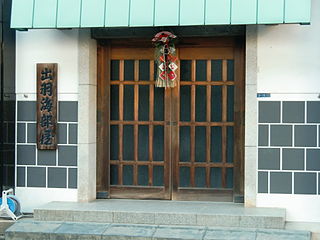
Dewanoumi stable is a stable of sumo wrestlers, part of the Dewanoumi ichimon or group of stables. It has a long, prestigious history. Its current head coach is former maegashira Oginohana. As of January 2018 it had 14 wrestlers.

Masurao Hiroo is a Japanese former sumo wrestler, born Hiroo Teshima in Itoda, Fukuoka Prefecture. Making his professional debut in 1979, he reached the top division in 1985. His highest rank was sekiwake and he won five special prizes in his top division career. He was one of the lightest wrestlers in the top division, and very popular with tournament crowds. In his later career he suffered from a number of injuries, particularly to his knee, and he retired in 1990 at the age of 29. He is now the head coach of Ōnomatsu stable and a director of the Japan Sumo Association.
The following are the events in professional sumo during 2006.
The following are the events in professional sumo during 2003.
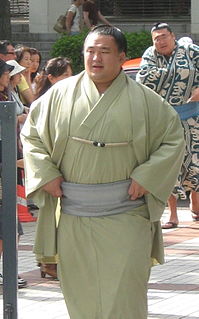
Tamawashi Ichirō is a professional sumo wrestler from Ulaanbaatar, Mongolia. He made his debut in January 2004 and reached the top makuuchi division in September 2008. His highest rank has been sekiwake. He has a makushita, a jūryō and a makuuchi division championship. He has two gold stars for defeating a yokozuna, and three special prizes. He wrestles for Kataonami stable. He has not missed a bout in his career to date and has the longest streak of consecutive matches among active wrestlers. In January 2019, he won his first top-division championship at the age of 34.
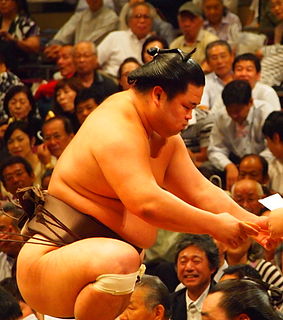
Myōgiryū Yasunari is a professional sumo wrestler from Takasago city in Hyōgo prefecture, Japan. Making his debut in May 2009 as a makushita tsukedashi out of university, he reached the top division for the first time in November 2011. His highest rank to date has been sekiwake. He has earned five special prizes for Technique.
Kurohimeyama Hideo is a former sumo wrestler from Ōmi, Niigata, Japan. He made his professional debut in March 1964, and first reached the top division in July 1969. After he was re-promoted to the top division in November 1969 he fought there for 71 consecutive tournaments and 1065 matches, never missing a single bout. His highest rank was sekiwake. He made 18 appearances in the lower sanyaku ranks but unusually for someone with that level of success never won a tournament championship (yusho) in any division. He retired in January 1982 and became an elder in the Japan Sumo Association. He worked as a coach at Tatsunami stable, and his two sons were both wrestlers there under the shikona of Haguronada and Hagurokuni. He borrowed the Nishikijima, Yamahibiki, Dekiyama and Kitajin elder names before permanently acquiring the Takekuma name in 1988 upon the mandatory retirement of ex-sekiwake Kitanonada. Following the retirement of Tatsunami's stablemaster in 1999 he branched out to open up his own Takekuma stable, although it folded after only five years in 2004 after his only remaining wrestler (Hagurokuni) retired, and he moved to Tomozuna stable. He reached the Sumo Association's mandatory retirement age of 65 in November 2013. His grandson Toranosuke joined Sakaigawa stable in May 2018 and fights as Tanakayama.
Fukunohana Koichi is a former sumo wrestler from Kōshi, Kumamoto, Japan. He made his professional debut in January 1958 and reached the top division in September 1965. His highest rank was sekiwake. He retired in November 1975.

Tokitsuyama Jin'ichi was a professional sumo wrestler from Iwaki, Fukushima, Japan who wrestled for Tatsunami stable. He won the top division sumo championship in the summer tournament of 1953 and was runner-up in five other tournaments. His highest rank was sekiwake. After his retirement in 1961 he worked as a coach at Tatsunami stable until his death in 1968.

Ichinojō Takashi is a sumo wrestler from Arkhangai, Mongolia. He is notable as being the second foreign-born wrestler, and the first of non-Japanese descent allowed to debut at an elevated rank in the third makushita division due to his amateur sumo success. In only his third professional tournament he took the second division jūryō championship. In his fifth professional tournament, his first in the top makuuchi division, he was the runner-up and promoted all the way to sekiwake, his highest rank to date. He is the heaviest man in the top division as of March 2019.


